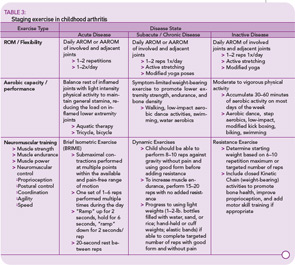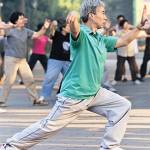Many children whose disease is well-controlled or inactive want to play a sport. A PT can help the child choose a sport that matches his or her abilities and interests and develop a training program to remediate deficits in strength, endurance, motor skills, and neuromuscular control, thereby reducing the risk of injury (See fig. 1). Low impact drills that challenge movement speed, agility, and coordination add interest to a conditioning regimen. Finally the child should be taught how to recognize the signs of overuse, use RICE (rest, ice, compression, elevation) for pain and swelling, and modify his or her activities to reduce stress to the joint.
Dr. Klepper is assistant professor of clinical physical therapy at Columbia University, College of Physicians and Surgeons in New York City.
References
- Klepper SE. Exercise and fitness in children with arthritis: evidence of benefits for exercise and physical activity. Arthritis Care Res. 2003;49:435-443.
- Lelieveld OT, van Brussel M, Takken T, et al. Aerobic and anaerobic exercise capacity in children with juvenile idiopathic arthritis. Arthritis Care Res. 2007;57:898-904.
- Van Brussel M, Lelieveld OT, van der Net J, et al. Aerobic and anaerobic exercise capacity in children with juvenile idiopathic arthritis. Arthritis Care Res. 2007;57:891-897.
- Myer G, Brunner HI, Melson PG, et al. Specialized neuromuscular training to improve neuromuscular function and biomechanics in a patient with quiescent juvenile rheumatoid arthritis. Phys Ther. 2005;85:791-802.
- Singh-Grewal D, Wright V, Bar-Or O, Feldman BM. Pilot study of fitness training and exercise testing in polyarticular childhood arthritis. Arthritis Care Res. 2006;55:364-372.
- Epps H, Ginnelly L, Utley M, et al. Is hydrotherapy cost-effective? A randomized controlled trial of combined hydroptherapy programmes compared with physiotherapy land techniques in children with juvenile idiopathic arthritis. Health Technol Assess. 2005;9:1-59.
- American Physical Therapy Association. Guide to Physical Therapist Practice, 2nd Edition. APTA, Alexandria, Va.; 2001.




